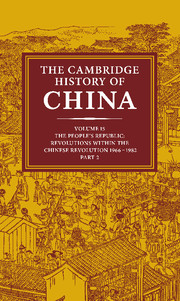Book contents
- Frontmatter
- 1 Mao Tse-tung's thought from 1949 to 1976
- PART I THE CULTURAL REVOLUTION: CHINA IN TURMOIL, 1966–1969
- PART II THE CULTURAL REVOLUTION: THE STRUGGLE FOR THE SUCCESSION, 1969–1982
- PART III THE CULTURAL REVOLUTION AND ITS AFTERMATH
- PART IV LIFE AND LETTERS UNDER COMMUNISM
- PART V THE SEPARATED PROVINCE
- Epilogue: the onus of unity
- Appendixes: meetings and leaders
- Bibliographical essays
- Bibliography
- Index
- Map 1: China’s physical features
- Map 2. PRC: political (Wade–Giles romanization)
- Map 3. PRC: political (pinyin romanization)
- Map 7: Population
- References
1 - Mao Tse-tung's thought from 1949 to 1976
Published online by Cambridge University Press: 28 March 2008
- Frontmatter
- 1 Mao Tse-tung's thought from 1949 to 1976
- PART I THE CULTURAL REVOLUTION: CHINA IN TURMOIL, 1966–1969
- PART II THE CULTURAL REVOLUTION: THE STRUGGLE FOR THE SUCCESSION, 1969–1982
- PART III THE CULTURAL REVOLUTION AND ITS AFTERMATH
- PART IV LIFE AND LETTERS UNDER COMMUNISM
- PART V THE SEPARATED PROVINCE
- Epilogue: the onus of unity
- Appendixes: meetings and leaders
- Bibliographical essays
- Bibliography
- Index
- Map 1: China’s physical features
- Map 2. PRC: political (Wade–Giles romanization)
- Map 3. PRC: political (pinyin romanization)
- Map 7: Population
- References
Summary
Like Lenin, Mao Tse-tung, on coming to power, continued to develop his ideas in a context different from that within which he had operated while in opposition. In so doing, he modified, adapted, and elaborated positions he had adopted earlier. In many respects there was substantial continuity, but there were also startling ruptures and reversals, and in addition, Mao struck out in new directions he had never previously had the occasion to explore.
One important constant in the development of Mao Tse-tung's thought was his concern to adapt Marxism, or Marxism-Leninism, to the economic and social reality of a backward agrarian country, and to the heritage of the Chinese past, which for Mao was no less real. Before the conquest of power, the first aspect of this project involved devising theoretical justifications for attributing to the peasantry a political role greater than that implied by the model of the October Revolution, and more specifically for the strategy of surrounding the cities from the countryside. In this respect, it might have been assumed, and probably was assumed by Mao himself in 1949, that Chinese practice, and Chinese theory, would move closer to that of the Soviet Union. Having taken power in the cities as well as in the countryside, the Chinese Communist Party was effectively in a position to develop modern industry, and thus to create its own supposed class basis as the “vanguard of the proletariat,” and to open a road to convergence with more advanced countries under communist rule.
- Type
- Chapter
- Information
- The Cambridge History of China , pp. 1 - 104Publisher: Cambridge University PressPrint publication year: 1991

